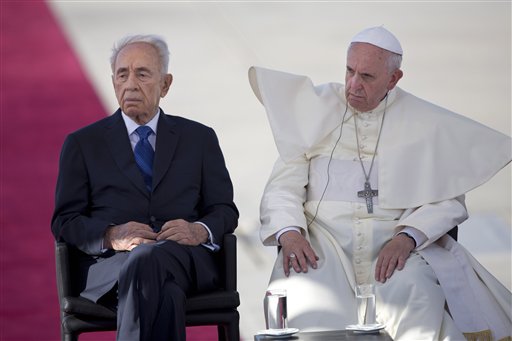
Pope Francis, right, and Israeli President Shimon Peres, left, listen to Prime Minister Benjamin Netanyahu’s speech, during an official arrival ceremony at Ben Gurion airport near Tel Aviv, Israel, Sunday, May 25, 2014. May 25, 2014. Peres and Palestinian President Mahmoud accepted the Pope’s surprise invitation to them to pray with him for peace in the Vatican next month. AP PHOTO/ODED BALILTY
JERUSALEM—Pope Francis called on Christians, Jews and Muslims to work together for peace as he toured holy sites in Jerusalem on Monday, the final day of his Middle East pilgrimage.
On an early-morning tour of key sacred places in the walled Old City, the 77-year-old Pontiff first visited the Al-Aqsa mosque compound, then prayed at the Western Wall that lies just beneath it.
The tour followed the acceptance on Sunday by Palestinian President Mahmoud Abbas and Israeli President Shimon Peres of the Pope’s surprise invitation to them to pray with him for peace in the Vatican next month.
Francis extended the invitation to the two leaders during Mass at Manger Square that followed the Pontiff’s arrival on Sunday morning in Bethlehem, the traditional birthplace of Jesus.
“I offer my home in the Vatican as a place for this encounter of prayer,” Francis said.
The offices of the Israeli and Palestinian presidents quickly confirmed that they had accepted the invitation, with the Palestinians saying the meeting would take place on June 6.
The invitation and the acceptances were unexpected, given Francis’ insistence that his three-day visit was a “strictly religious” pilgrimage to commemorate a Catholic-Orthodox anniversary.
But it showed that the Pope, who is named after the peace-loving St. Francis of Assisi, has been able to channel his immense popular appeal to be a moral force for peace, even though the proposed meeting will be largely a symbolic affair.
Work for justice and peace
Although Francis had promised that his pilgrimage, which began on Saturday in Jordan, would steer clear of political issues, he ad-libbed from his scripted speech on Monday to condemn anti-Semitism, religious intolerance and those behind conflicts in the Middle East.
“May we work together for justice and peace,” Francis said after being shown around the Al-Aqsa compound, which is also considered sacred by Jews because it was the site where their two famed Jerusalem temples once stood.
Later in the morning, Francis visited the Yad Vashem Holocaust museum where he spoke with survivors and became the first Pope ever to lay flowers on the grave of Theodore Herzl, the founder of modern Zionism.
At the end of the day, the Pope also celebrated Mass at the site known as the Cenacle, or Upper Room, bringing into sharp focus a decades-long debate over prayer rites at the site where Christians believe Jesus had his Last Supper.
The site on Mount Zion is located in a two-story building also considered holy by Muslims and Jews who regard it as the place where the biblical figure David was buried.
In a boost for relations between bickering Christians, Francis also joined Orthodox Patriarch Bartholomew I in a historic joint prayer for unity between Rome and Constantinople.
Diplomatic dance
The pair met, embraced and kissed at the Church of the Holy Sepulcher inside the Old City to mark the historic meeting 50 years ago between Pope Paul VI and Patriarch Athenagoras—the first easing of tensions between the Churches since the Great Schism of the 11th century.
Francis has said the main reason for his Middle East visit was the meeting with Bartholomew I and “to pray for peace in that land, which has suffered so much.”